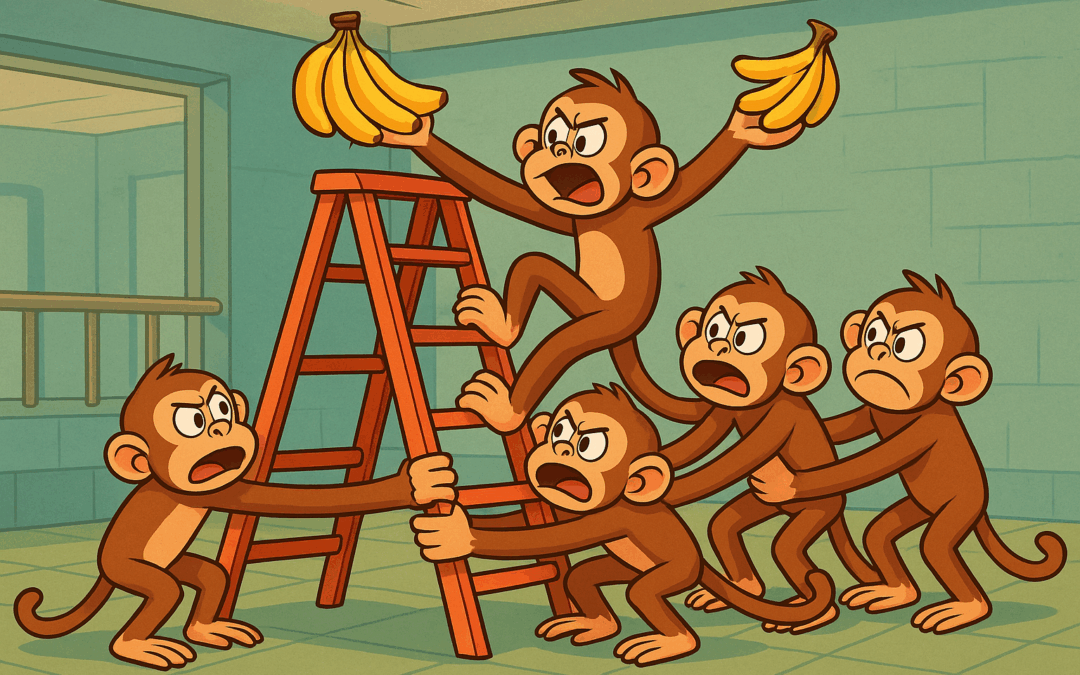New ideas can be tough to swallow, and change can be hard to accept. But we can’t grow without unless we challenge the status quo.
I recently heard a story about researchers who put five monkeys in a room with a ladder. At the top of the ladder was a bunch of bananas, and every time a monkey tried to climb the ladder to reach the bananas, the researchers would spray them with water.
Monkeys hate getting wet, and eventually they gave up and stopped trying to climb the ladder, ignoring the bananas altogether. That’s when the real experiment began.
The researchers then replaced one monkey with a new monkey. It immediately went to try and get the bananas, but the other monkeys kept pulling it off the ladder to prevent it from getting sprayed. Soon the new monkey gave up on the bananas.
One by one, the researchers replaced all the original monkeys until finally none of the monkeys had been sprayed with water for trying to climb the ladder. They didn’t know why they shouldn’t climb the ladder—they just didn’t do it.
It’s what they’ve always done!
While I have no idea if this was an actual research project, I have seen this very thing play out in businesses, churches, schools, nonprofits, and organizations big and small. I’ve even seen it happen in the lives of individuals who resist innovation and keep doing things the same way they’ve always been done.
Fear of Change and Growth
I think there are several lessons here. The first is how often we stifle new ideas. Whether they come from the new girl on the team or someone who’s been on the team for a while, we can be too quick to dismiss new ideas, fresh strategies, or innovative approaches.
The truth is new ideas are not always bad. If you keep doing the same thing you’ve always done, you’re going to get the same results you’ve always gotten.
It is also a fact that change is scary. Trying new things creates more opportunities for failure. It means we might have to stretch and grow to be able to handle the new challenges that come our way.
Too often, we’d rather live with familiar results—even if they are less than optimal—than try something new.
How Pushback Kills Motivation and Innovation
The second lesson in this story is how quickly we can give up on trying to be a change-maker. The new monkey has great vision, innovative ideas, and motivation to achieve success.
But when they start getting pushback on even the simplest ideas, they give up and follow the crowd.
This is a dead giveaway that the person has stopped caring about the outcome. Maybe they see the apathy of everyone else and realize there’s nothing to gain by trying to swim upstream.
When this happens, it always comes at the cost of drive, motivation, and results.
3 Steps to Challenge the Status Quo and Drive Success
I don’t think many of us have gone through life without seeing this situation play out at some point. So how do we keep from becoming a bunch of hungry monkeys?
There are three simple steps you can take to avoid doing things the same way you’ve always done them—just because.
1. Clearly Define Success
When you have a clear definition of what success looks like, it’s easier to review strategies, processes, and new ideas against that definition. If the old way of doing things still makes the most sense, great—keep doing that.
If a new idea or strategy is better aligned with your desired outcome, it may be time to switch tactics.
2. Empower Your Team To Innovate
Once you know what success looks like, empower your team to innovate and make it happen. How they do it shouldn’t be your primary concern—stay focused on results. This encourages creativity and new ideas in the process.
When you micromanage the “how,” it’s easy for other team members to hold back their suggestions. This is especially true if you are vocal about how it should be done. Letting go of the “how” also frees you up to focus on other priorities.
3. Analyze and Improve Your Process
If you’re not ready to give up total control of the outcome just yet, talk through the process with your team. Look at where the pain points are. Discuss ways to iron out the wrinkles, improve processes, and boost results.
Often the issue is simply a lack of communication. It may not be that your whole process is wrong—it might just be that people don’t fully understand it. Document each step and make sure everyone knows their role.
You don’t have to be like the monkeys in the research project if you’re willing to challenge the status quo. Even when things have gone well, I’m always asking myself how I can improve. Even a slight improvement can have a major impact.
Remember, if you’re not innovating, you’re not growing—and without growth, you’re not achieving your full potential.

